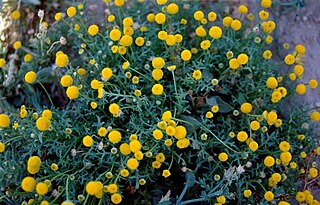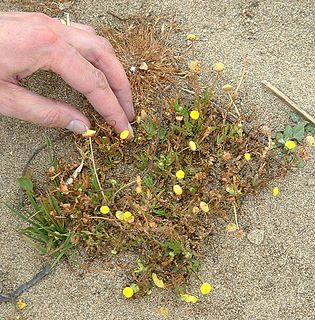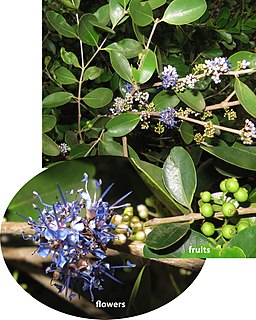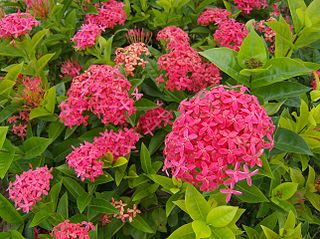
The Lamiales are an order in the asterid group of dicotyledonous flowering plants. It includes about 23,810 species, 1,059 genera, and is divided into about 24 families. Being one of the largest orders of flowering plants, Lamiales have representatives found all over the world. Well-known or economically important members of this order include lavender, lilac, olive, jasmine, the ash tree, teak, snapdragon, sesame, psyllium, garden sage, and a number of table herbs such as mint, basil, and rosemary. Lamiales and Orobanchaceae are both the largest populated parasitic angiosperms of flowering plants.

The Rubiaceae are a family of flowering plants, commonly known as the coffee, madder, or bedstraw family. It consists of terrestrial trees, shrubs, lianas, or herbs that are recognizable by simple, opposite leaves with interpetiolar stipules and sympetalous actinomorphic flowers. The family contains about 13,500 species in about 620 genera, which makes it the fourth-largest angiosperm family. Rubiaceae has a cosmopolitan distribution; however, the largest species diversity is concentrated in the tropics and subtropics. Economically important species include Coffea, the source of coffee, Cinchona, the source of the antimalarial alkaloid quinine, some dye plants, and ornamental cultivars.

Monocotyledons, commonly referred to as monocots, are grass and grass-like flowering plants (angiosperms), the seeds of which typically contain only one embryonic leaf, or cotyledon. They constitute one of the major groups into which the flowering plants have traditionally been divided, the rest of the flowering plants having two cotyledons and therefore classified as dicotyledons, or dicots.

The Restionaceae, also called restiads and restios, are a family of flowering plants native to the Southern Hemisphere; they vary from a few centimeters to 3 meters in height. Following the APG IV (2016): the family now includes the former families Anarthriaceae, Centrolepidaceae and Lyginiaceae, and as such includes 51 genera with 572 known species. Based on evidence from fossil pollens, the Restionaceae likely originated more than 65 million years ago during the Late Cretaceous period, when the southern continents were still part of Gondwana.

Aaronsohnia is a genus in the family Asteraceae, native to mainly non-salty steppes and deserts in North Africa and Middle East. It was named in 1927 after the agronomist Aaron Aaronsohn by the botanists Otto Warburg (1859–1938) and Alexander Eig (1894–1938)

Cotula is a genus of flowering plant in the sunflower family. It includes plants known generally as water buttons or buttonweeds.

Memecylon is a plant group in Melastomataceae. It consists of 350-400 species of small to medium-sized trees and shrubs occurring in the Old World tropics. Memecylon is a monophyletic group basal to the Melastomataceae clade. Memecylon taxa have more than 600 published basionyms. Diversity of this group is concentrated in tropical Africa, Madagascar, Sri Lanka, India and Malaysia.

Banksia sessilis var. sessilis is the most populous and most widespread variety of Banksia sessilis.

Ajania is a genus of flowering plants in the daisy family, described as a genus in 1955. The genus is native to temperate Asia, primarily Russia and China. It is named after the Russian port city Ayan in the Khabarovsk Krai region of the Russian Far East, on the coast of the Sea of Okhotsk.
Allardia is a genus of flowering plants in the daisy family described as a genus in 1841.
Hippolytia is a genus of flowering plants in the daisy family native to temperate Asia.
Xylanthemum is a genus of Asian plants in the daisy family.

Mauranthemum is a genus of flowering plants in the daisy family.

Richteria is a genus of Asian flowering plants in the daisy family. Described in 1842, the genus is named after botanist Alexander Richter.

Ixoroideae is a subfamily of flowering plants in the family Rubiaceae and contains about 4000 species in 27 tribes.

The taxonomy of Liliaceae has had a complex history since the first description of this flowering plant family in the mid-eighteenth century. Originally, the Liliaceae or Lily family were defined as having a "calix" (perianth) of six equal-coloured parts, six stamens, a single style, and a superior, three-chambered (trilocular) ovary turning into a capsule fruit at maturity. The taxonomic circumscription of the family Liliaceae progressively expanded until it became the largest plant family and also extremely diverse, being somewhat arbitrarily defined as all species of plants with six tepals and a superior ovary. It eventually came to encompass about 300 genera and 4,500 species, and was thus a "catch-all" and hence paraphyletic taxon. Only since the more modern taxonomic systems developed by the Angiosperm Phylogeny Group (APG) and based on phylogenetic principles, has it been possible to identify the many separate taxonomic groupings within the original family and redistribute them, leaving a relatively small core as the modern family Liliaceae, with fifteen genera and 600 species.

Spermacoceae is a tribe of flowering plants in the family Rubiaceae and contains about 1346 species in 57 genera. Its representatives are found in the tropics and subtropics.

Gardenieae is a tribe of flowering plants in the family Rubiaceae and contains about 586 species in 53 genera.

Glebionidinae is a small subtribe of flowering plants in the tribe Anthemideae of the family Asteraceae. Its members include species used in the production of garden marguerites.
Tanacetopsis is a genus of flowering plants belonging to the family Asteraceae.















